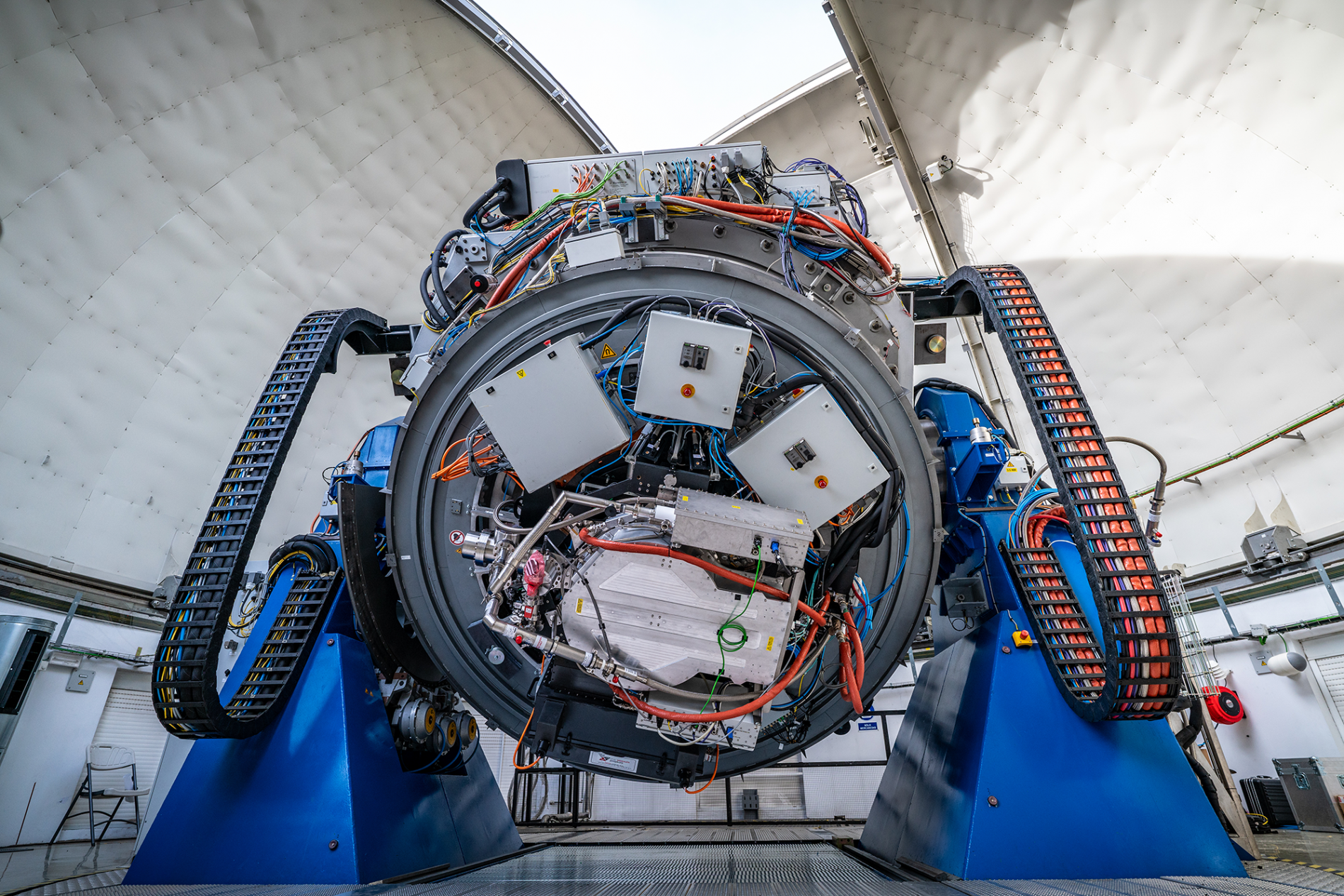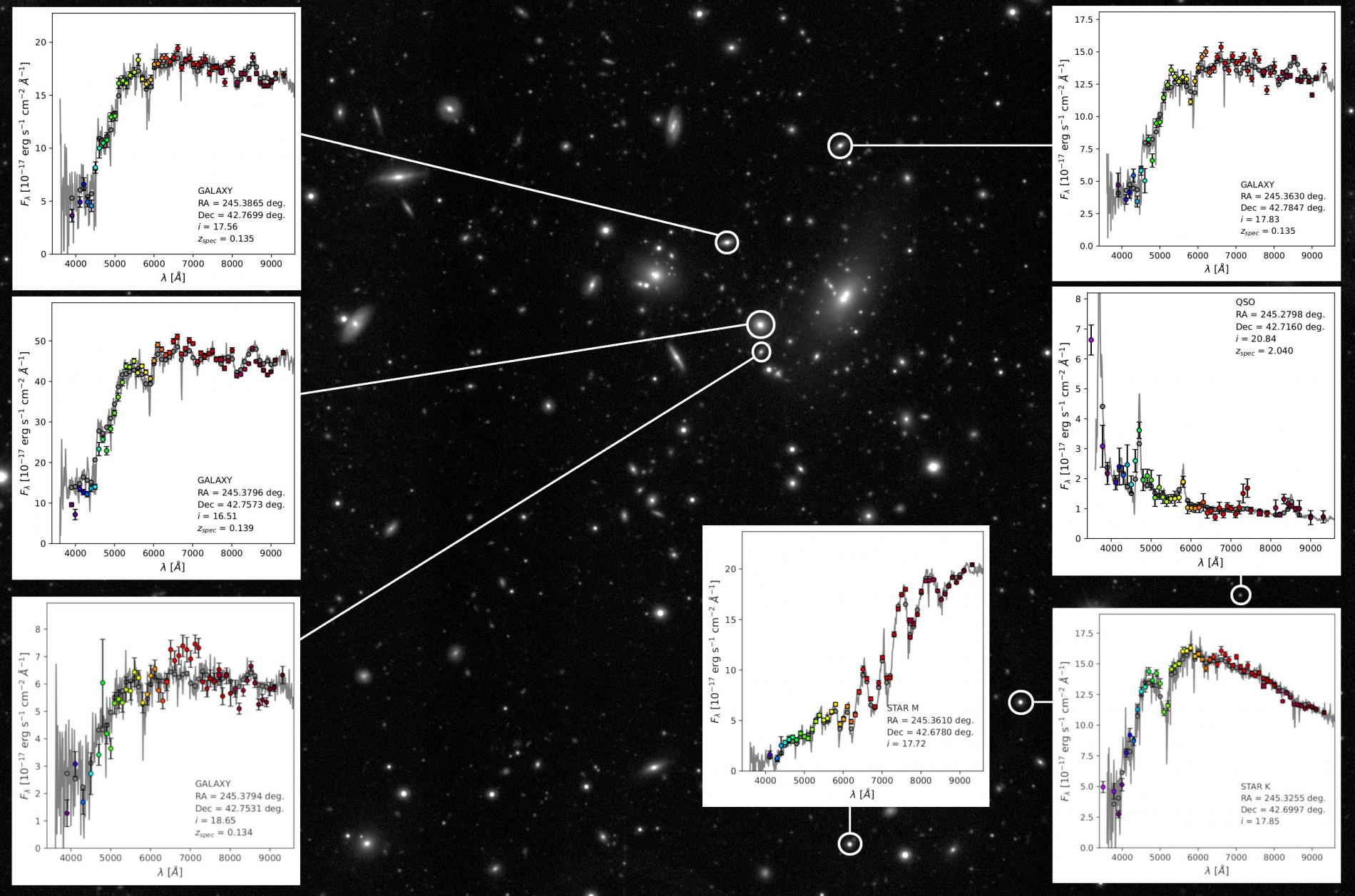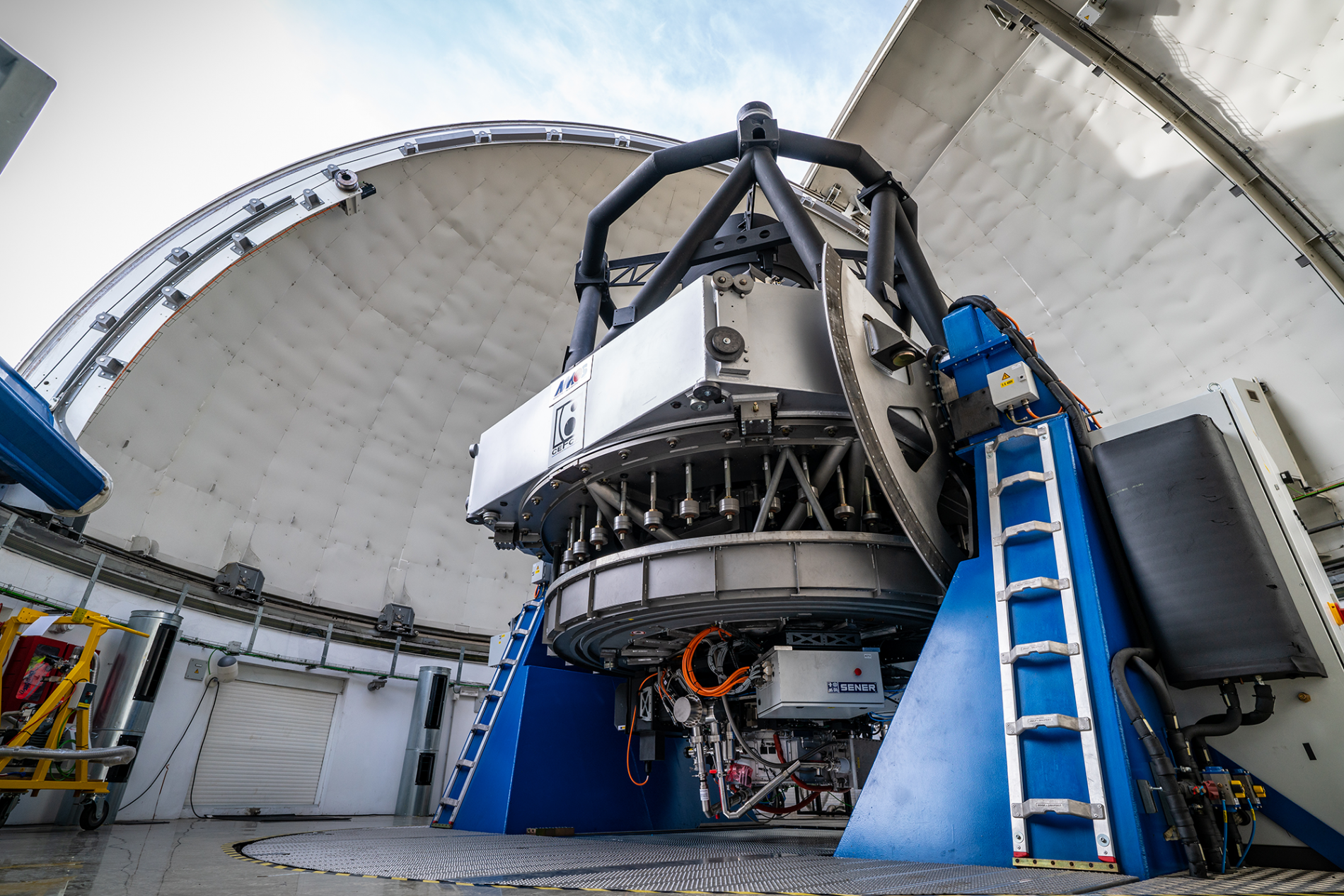J-PAS: largest mapping of the cosmos begins
It will observe hundreds of millions of galaxies from the Javalambre Astrophysical Observatory in order to understand the accelerating expansion of the Universe.
The Javalambre Astrophysical Observatory (OAJ) has just taken the first data from the J-PAS project (Javalambre Physics of the Accelerating Universe Astrophysical Survey), a large and unprecedented three-dimensional mapping of the cosmos that is planned to be carried out over the course of this decade.
It will observe thousands of square degrees of sky with hundreds of millions of galaxies and stars, with the ultimate goal of advancing our understanding of the nature of dark energy by studying the large-scale structure of the universe.
The project, led by the Centro de Estudios de Física del Cosmos de Aragón (CEFCA), together with the Instituto de Astrofísica de Andalucía (IAA-CSIC), the National Observatory of Rio de Janeiro and the University of Sao Paulo, is developed and scientifically exploited through an international collaboration with more than 250 researchers from 18 countries.
To carry out the mapping, the OAJ relies on the JST250 telescope, a "wide-angle" 2.5m main mirror, and the JPCam panoramic camera which, with more than 1.2 billion pixels, is currently the second largest astronomical camera in the world. In addition, JPCam integrates 56 internationally unique optical filters defined specifically for the project, allowing it to image multi-colour images of large areas of the sky and ultimately obtain detailed information on all objects in the field of view. All this makes the JPCam-JST250 "tandem" a machine capable of mapping the Universe and measuring extragalactic distances with the precision needed for its cosmological goals.

Image of the JPCam camera installed on the Javalambre Survey Telescope (JST250) at the Observatorio Astrofísico de Javalambre (OAJ). Image credit: Centro de Estudios de Física del Cosmos de Aragón (CEFCA).
The first J-PAS observations come after an arduous process of verification, tuning and optimisation of JPCam on JST250, carried out by CEFCA technical, engineering and research staff. In spring 2023, the last phase of commissioning began, which was recently successfully concluded after confirming that the JPCam-JST250 system meets the scientific-technical requirements initially foreseen, highlighting its excellent image quality over the entire field of view. In the words of Dr. Antonio Marín, deputy director of OAJ and head of the JPCam project at CEFCA, "JPCam is a prototype, in the sense that there is no other camera like it in the world. The 14 large-format CCD detectors that are integrated in the instrument were developed specifically for this project, as well as its complex control electronics and the J-PAS filter system itself". He adds: "Due to its very high technological complexity, the characterisation, validation and final commissioning of JPCam has been a challenge that has required new engineering developments during the commissioning phase".
So far, the first 15 square degrees of the mapping have been observed with the 56 J-PAS filters (equivalent to an area of 60 full moons). Although only the beginning, these data already include information for one million stars and galaxies.
Due to its large field of view, each JPCam image occupies about 1 GB of data, and hundreds of images can be taken each night of work. The large volume of data generated by J-PAS requires the OAJ to have a dedicated data centre for storage, management and calibration.
"The start of the J-PAS data acquisition is a very special moment as we are applying our multidisciplinary knowledge and experience from other OAJ mapping precursors to J-PAS to guarantee both the efficiency of the astronomical observations and the proper processing of the huge amount of images involved," says Dr. Héctor Vázquez, head of the Data Processing and Archiving Department at CEFCA. "CEFCA's goal is always to provide the scientific community with data of the highest possible quality in order to contribute to the advancement of knowledge," he concludes.

Comparative image of preliminary J-PAS data with available spectroscopic data. The background image is a small region of one of the J-PAS exposures. The plots present the J-PAS data in each of the 56 filters (in colour) against available spectra (in grey) of several galaxies, two stars and a quasar. Image credit: Centro de Estudios de Física del Cosmos de Aragón (CEFCA).
J-PAS is a legacy project for the international scientific community that is set to provide a unique view of the Universe. Both in terms of the type and the amount of information it will provide for each and every one of the hundreds of millions of astronomical objects it will systematically observe, it opens up new expectations for research in almost all fields of astrophysics.
José Manuel Vílchez, research professor at the IAA-CSIC and member of the International Steering Committee of the collaboration states that "J-PAS will provide unique information for the study of the multicoloured universe with the mapping of thousands of square degrees of the northern hemisphere sky. This is a titanic scientific milestone that advances the development of astrophysics in the coming years with fascinating new discoveries. J-PAS is a key project for the IAA-CSIC, to whose scientific development it contributes in practically all areas, from the study of the Solar System, stars, galaxies and their clusters, to the largest large-scale structures that we can observe in the cosmos. J-PAS is part of the strategic project "Severo Ochoa" of the IAA-CSIC".
The J-PAS project was the scientific engine for the definition and construction of the OAJ which, since 2014, belongs to the map of Singular Scientific and Technical Infrastructures (ICTS) of the Ministry of Science and Innovation. With the launch of JPCam, the OAJ ICTS is now fully operational. The launch of J-PAS is also a fundamental milestone in the project "Advanced technologies for the exploration of the Universe and its components" of the call for Complementary Plans with Autonomous Communities which, within the area of Astrophysics and High Energy Physics, is jointly executed by Andalusia, Aragon, the Balearic Islands, Cantabria, Catalonia, Madrid and the Valencian Community with co-financing from the Recovery, Transformation and Resilience Plan, financed by the European Union - NextGenerationEU. CEFCA coordinates this project in Aragon and relies on the Teruel Investment Fund to co-finance R&D&I activities related to JPCam and J-PAS. The IAA-CSIC and the UGR coordinate the Complementary Plan in Andalusia.

Javalambre Survey Telescope (JST250) of the Javalambre Astrophysical Observatory and its scientific instrument JPCam. Credit: Centro de Estudios de Física del Cosmos de Aragón (CEFCA).
About IAA-CSIC
The Instituto de Astrofísica de Andalucía (IAA) is a centre of the Consejo Superior de Investigaciones Científicas (CSIC). Its mission is to deepen our knowledge of the cosmos and to bring it closer to society by conducting cutting-edge astrophysical and space science research, promoting technological development through the construction of new instrumentation and disseminating our research among the scientific community and the general public through outreach activities. The IAA-CSIC is a Severo Ochoa Centre of Excellence, an accreditation that recognises centres that carry out cutting-edge basic research and are among the best in the world in their area of work.
About CEFCA and OAJ
The Centro de Estudios de Física del Cosmos de Aragón (CEFCA) is an astrophysics research institute of the Government of Aragon founded in 2008 and located in Teruel. Its activities are focused on the development, operation and scientific exploitation of the Observatorio Astrofísico de Javalambre (OAJ), an astronomical Singular Scientific and Technical Infrastructure (ICTS) equipped with two telescopes specially designed to carry out large-scale mapping of the sky, unique in the world. The CEFCA is mainly participated by the Government of Aragon and the Ministry of Science and Innovation, and constitutes an Associated Unit of the CSIC with the Instituto de Astrofísica de Andalucía.
The OAJ and the J-PAS project are funded by CEFCA and by the Governments of Aragon and Spain through the Teruel Investment Fund, the European Regional Development Funds, the Recovery, Transformation and Resilience Plan (NextGenerationEU) of the Ministry of Science and Innovation and the State Research Agency. The Brazilian agencies FINEP, FAPESP, FAPERJ and the National Observatory of Brazil have contributed to the funding of JPCam. Additional funding for J-PAS has been provided by the Estonian Tartu Observatory and the Chinese J-PAS Astronomical Consortium.
About ICTS
The Singular Scientific and Technical Infrastructures (ICTS) are large facilities, resources, equipment and services, unique in their kind, which are dedicated to cutting-edge research and technological development of the highest quality, as well as to promoting the transmission, exchange and preservation of knowledge, technology transfer and innovation.
ICTS are unique or exceptional of their kind, and their importance and strategic nature justifies their availability to the entire R&D&I community. ICTS have three fundamental characteristics: they are publicly owned infrastructures, they are unique and they are open to competitive access.
Contact:
Dr. José Manuel Vílchez (Miembro del Consejo de Dirección Internacional de J-PAS), IAA-CSIC, jvm@iaa.csic.es
Unidad de Divulgación y Comunicación

